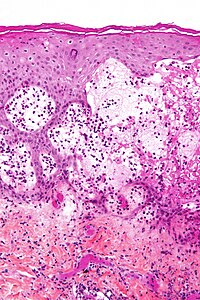Pemphigoid Gestationis

Pemphigoid gestationis (PG) is a pregnancy-associated, autoimmune skin disorder. It usually begins abruptly during the 2nd or 3rd trimester of pregnancy, but it can begin at any time during pregnancy. Signs and symptoms often include the sudden formation of very itchy, red bumps and/or blisters on the abdomen and trunk, which may then spread to other parts of the body. Unrelenting itchiness (pruritus) often interferes with daily activities. Symptoms may improve at the end of pregnancy, but flares may occur during, or right after, delivery. While PG usually goes away on its own within weeks to months after delivery, it has been reported to persist for years in some cases. PG is caused by a woman's immune system producing autoantibodies and mistakenly attacking her own skin, but the trigger for autoantibody production is poorly understood. Treatment aims to relieve itching and prevent blister formation, and may involve the use of topical corticosteroids, oral corticosteroids, and/or oral antihistamines. The lowest effective dose of medication should be used in order to minimize the risk to the mother and fetus. The disorder may recur at a later time such as when menstruation resumes; with use of oral contraceptives; and/or during subsequent pregnancies.